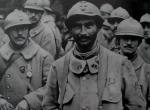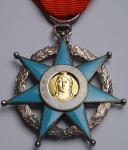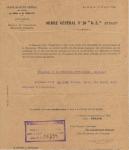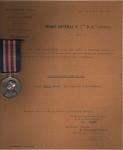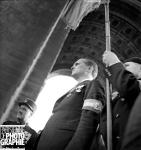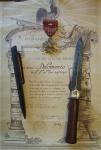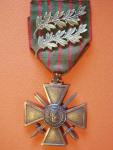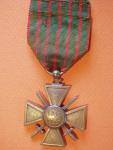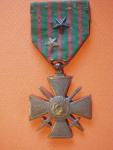-
Posts
402 -
Joined
-
Last visited
-
Days Won
2
Content Type
Profiles
Forums
Blogs
Gallery
Events
Store
Everything posted by Bison
-
The three first are not military, these are provinces or towns of France. The last one is the patch of the 9th Marine Division (9?me Division d'Infanterie de Marine).
-
-
The stars made by jewellers are the best choice, and you are lucky palencia, there is one. Here is another, made by Aubert, with the center in gold in two parts on the observe : http://gmic.co.uk/uploads/monthly_12_2008/post-2068-1230486482.jpghttp://gmic.co.uk/uploads/monthly_12_2008/post-2068-1230486496.jpg
-
-
In the first post, it is a French-made MM. But with it is also this one, not named, and British-made I suppose. This is the medal I bought. It was very probably awarded to private Henri COSTE, 22nd Infantry Regiment. Observe :
-
Thank you Chris for the link! I have missed this topic. Very interesting figures.
-
And another from the Grande Chancellerie de la L?gion d'honneur, for another DCM, signed by the President, in 1921 : I should be very happy to read your comments on these documents.
-
-
I just bought a Military Medal awarded to a French soldier during WW1. Very happy with this, but there is no name engraved on it, unlike for the British ones. By chance I get this document with it :
-
Very nice ! It is a superb medal of Officier de l'Instruction Publique. Just a remark. The Order of the Palmes Acad?miques exists only from 1955. Before that date, from 1808 to 1955, it was just a distinction for teachers and professors. A sort of university distinction, let's say. The two ranks (and not degree or grade) were 'Officier des acad?mies' and 'Officier d'Universit?'. At the very beginning they were embroided on the academic gown. During the Second Republic, in 1848 - 1852, the first medals appeared hanging on a purple ribbon (and the professor's gowns disappeared). At this period, the wording of the ranks changed to 'Officier d'acad?mie' and 'Officier de l'Instruction Publique'. In 1955 the Palmes Acad?miques were organized as an Order, with three degrees : Chevalier, Officier and Commandeur. It is only after this date that we can consider it as a real Order. At this occasion, the badge changed, and is only constituted of two palms (Christophe showed an example). However it is the second most ancient distinction instituted by Napoleon still active in France with the L?gion d'honneur. Regards Biosn
-
Fully agree with Hendrik. The bronze model, engraved with the mark of the Monnaie de Paris, is really not usual. It shows also the so called "?paule haute" type... The fact that the Monnaie de Paris made it is a surprise ! This model is a mistery for me, and certainly a very nice find.
-
It is probably a model of Paul Delande. However, the first in the left side is an unusual one, never seen before... It seems to be not in silver? Regards Bison
-
Yes, this kind of document are always very interesting... and we hardly imagine this kind of actions nowadays. I also proposed the same kind of citation in another post : "-24th Infantry Division- Is mentioned to the division level (silver star) : Private DELOMENIE Jean ID Nr 2060 C.H.R (special Company) of the 126 Infantry Regiment Very good soldier, brave and courageous. The 24th October 1918 during a raid, he was tasked to clean the enemy trenches and shelters. He completed its mission with much entrain, contributing to capture number of prisoners" I display with it a French trench knive, model 1916, often known as "le vengeur". This one is marked "Le Chinois"-"Bourgade" and you can see the chinese head on it. On your document, the soldier was also appointed to the C.H.R. which stands for "Compagnie Hors Rang", we could translate as a special company in which the trenc raiders were...
-
As far as I know, there were no chevrons in the collar tabs in WW1 (To be confirmed). The code of chevrons came later, in the 20's, I think. The grenade on the buttons = Infantry, for sure. Artillery has normally (?) two cannons crossed behind the grenade. But in these years of war, everything was possible, so consider my post only just as an advice... I am more confortable in awards and orders.. Regards
-
The winged bomb was a generic symbol for the Army, coming from Infantry and especially grenadiers (of the Guard). The distinctions stand on background colors and chevrons. For infantry, the background was dark blue, with two red chevrons. For artillery, the background was red, with two (or three) blue chevrons For engineers, the background was black (on thick velvet!), with two (or three) red chevrons For cavalry, it depense... for example, Hussards were on light blue with dark blue chevrons... Dragoons, Cuirassiers, Chasseurs were different. Foreign Legion was on dark blue (sometimes black) with three green chevrons. And the winged bomb has its center empty, with seven flames. And so on for all other services and sometimes some particular regiments. It is a huge and complicated issue, because this changed often during the last two centuries. Do not focus on the grenade -or winged bomb-, but on the colors and chevrons of the collar tab which are supposed to remember the main colors of the former uniforms which disapeared in the beginning of WW1.
-
And the first of your fourth post is about the 46th Infantry Regiment "La Tour D'Auvergne". This regiment was posted in Berlin during the Cold War. For the others I do not know.
-
Hi Russiamilitaria, These are very different patches. First post : 1st Army Corps (and 4th military region command), 2nd Army Corps. Second post : 7th armoured Division, 15th Infantry Division, 2nd Armoured Division. Third post : this are 'touristic' patches for regional tours, but nothing military : France (OK, fine), Dinan in Britanny (fine too, yes), France OK OKx2 nice! Regards Bison
-
Yes it is, obviously. The HQ armbands are quite scarce. They were worn in the 1900's and in the very beginning of WWI. The others are also fully interesting, but not so rare and related to right wing political movements in the 30's. To answer your question about the veteran movements : V.N. stands for "Volontaires Nationaux" (national volonteers) which was a sub organization of the "Croix de feu". Those who belong to the "Croix de feu" were mentioned during WWI. Those who belong to "V.N." were sympathizers or supporters (but not mentioned veterans ). The "torch" was also the name and symbol of the newspaper of this organization. Regards Bison
-
Good evening Garth The first armband is for the Staff officers of a Army Corps, the 6th in this case. The second (without number) is for the SO of the personal military staff of the French president. On your second post, it is armbands for veterans after the WW1. As you can see on this picture of Colonel de la Rocque, famous leader of a veteran movement "les croix de feu" after WWI. Regards
-
Bonsoir Chris "Peu importe le flacon, pourvu qu'on ait l'ivresse" Alfred de Musset (regardless of the bottle so it was drunkenness) Congrats for having this medal, the general commanding the Foreign Legion confirmed the attribution to you. That is to say you really deserved it. Regards Bison
-
Bonsoir PKeating May I continue with this other : "24th Infantry Division Is mentioned to the division level (silver star) : Private DELOMENIE Jean ID Nr 2060 C.H.R (special Company) of the 126 Infantry Regiment Very good soldier, brave and courageous. The 24th October 1918 during a raid, he was tasked to clean the enemy trenches and shelters. He completed its mission with much entrain, contributing to capture number of prisoners" regards Bison
-
And here is another "improved" croix 1914 - 1915, with two unusual palms http://gmic.co.uk/uploads/monthly_12_2008/post-2068-1228325145.jpghttp://gmic.co.uk/uploads/monthly_12_2008/post-2068-1228325179.jpg
-
Veteran is right: the croix de guerre are often neglected, however it is and endless and fantastic subject of study. Moreover these croix witness so much History, sacrifice, sufferings and blood. To continue, here is another with two different stars http://gmic.co.uk/uploads/monthly_12_2008/post-2068-1228324965.jpghttp://gmic.co.uk/uploads/monthly_12_2008/post-2068-1228324990.jpg
-
This monocular colonel seems to be a senior staff officer, his service could be Artillery (if the colors of the collar badges is red).. He has been wounded once, as the chevron on his right arm shows. He spent four years in the front during WW1, as the seven chevrons on his left arm show. He is probably personally owner of the fourrag?re, as far as he is in a headquarters (collar symbols). This implies he participated to all actions which drive to the attribution of this collective award to his regiment. (No one headquarters got a fourrag?re. It was exclusively awarded to fighting and brave units, which does not mean that a HQ is not capable of bravery ) The number of palms on the croix de guerre confirms this assumption. He was probably commanding officer of a battalion or a regiment, because they were personally awarded when their unit was collectively mentioned. This picture could have been taken in the 20s... All that is to be confirmed. Elementary my dear Watson! But his ID ... mmm Regards Bison




